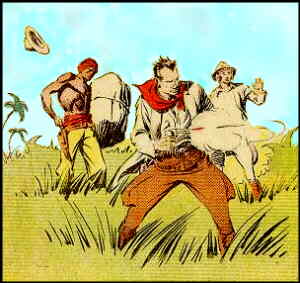| … corresponding to United Feature Syndicate's Tarzan, was the topper to Flash Gordon, the one taking on Buck. Both debuted on January 7, 1934 — which, by an odd coincidence, happened to be the fifth anniversary of both Tarzan and Buck.
Like Flash, Jungle Jim was created by writer Don Moore, who came straight out of the pulps and his style showed it; and artist Alex Raymond, whose prior credits included assistant gigs on Tim Tyler's Luck, Tillie the Toiler and Blondie. Moore didn't go on to anything of note in comics, but Raymond later drew Secret Agent X-9 and Rip Kirby.
"Jungle" Jim Bradley was not of the loincloth set, like Ka-Zar, Kaanga and many other jungle heroes, including of course Tarzan himself. He was more the "white hunter" type, with jodhpurs, side-arms and suchlike — that is, if the term "white hunter" had been in use where Jim hung his pith helmet, the jungles not of Africa, but of Southeast Asia and nearby large islands. A big, brawny native named Kolu played Lothar to Jim's Mandrake — that is, member of a non-white race who was a perfectly competent adventurer in his own right, but still acted subservient toward the fair-skinned hero. A year or two later, Moore added a femme fatale named Lilli deVrille to the cast.
By the late 1930s, Jim was getting involved with urban law enforcement officers, and became more urban himself. When the U.S. entered World War II, he turned his attention away from the slave traders, river pirates and other jungle menaces he'd previously subsisted on, and started taking on the Japanese. Another effect of World War II was to create paper shortages, shrinking the size of comics and leaving little room for toppers. Some toppers went off to Funny Papers Heaven, but Jungle Jim became an independent Sunday strip.
Raymond joined the Marines in 1944, and Jungle Jim never again looked as good. From a succession of unsigned artists, John Mayo eventually emerged. His most notable credit seems to be a strip called Future Eye, which was scripted by Jerry Siegel (co-creator of Superman), and which McClure Syndicate (School Days) launched in 1952 or '53 and folded in 1953 or '54. In 1948, Paul Norris (co-creator of DC Comics' Aquaman, TNT & Dan the Dyna-Mite, and Darwin Jones) took over. He kept it until 1952, when he began his long association with Brick Bradford, after which Jungle Jim was again drawn by Diverse Hands. Moore stayed on the scripts all through the artist roulette. The strip folded in 1954, never having gotten into the daily papers.
Jungle Jim's media penetration never was particularly intense, but it lasted a long time — in fact, it out-lived Jim's career in newspaper comics by well over a decade. It started November 2, 1935, with a weekly radio show. Then came a 12-part movie serial, produced by Universal Pictures, with Grant Withers in the title role, released in 1936. During the late '30s and into the '40s, the strip was reprinted in the back pages of Ace Comics alongside such other King Features stalwarts as Prince Valiant and Believe It or Not. Starting with a December 15, 1948 release, Columbia Pictures did a minor series of feature-length movies about the character, starring Johnny Weismuller, the last of which came out in 1952. From 1949-51, Standard Comics (Pyroman, Jetta of the 21st Century) published 11 Jungle Jim comic books.
Then came the posthumous stuff, the things that went on after the strip was gone. Dell Comics published 20 issues of Jungle Jim between 1953 and '59. Weismuller reprised his role in a one-season (1955-56) TV series. When King Features went into the comic book business, it occasionally ran Jungle Jim stories in the back pages, and even published him in a oneshot comic book in 1967. Jim's last comic book publisher was Charlton, which put out seven issues between 1969 and '70.
Now that Jungle Jim has been gone almost as long as he ran, in all media — it is possible we might actually have seen the last of him?
— DDM
BACK to Don Markstein's Toonopedia™ Home Page
Today in Toons: Every day's an anniversary!
| |
Purchase Toon-related Merchandise Online
|
